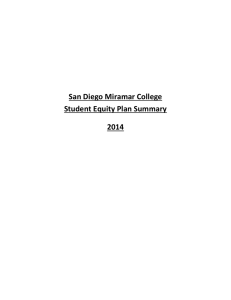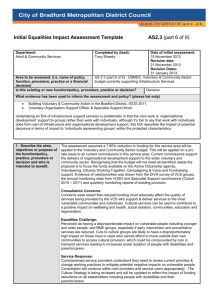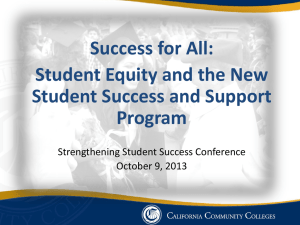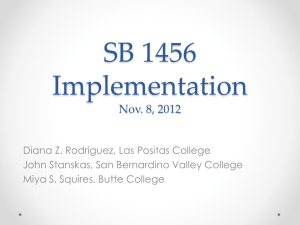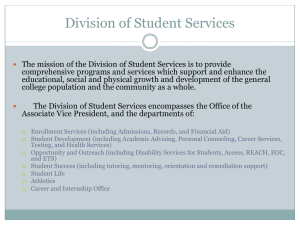Assessing and Mitigating Disproportionate Impact in
advertisement
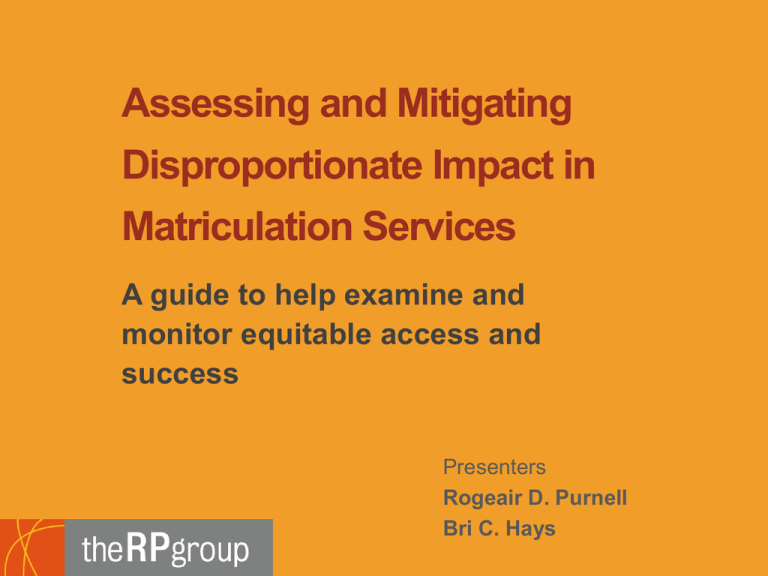
Assessing and Mitigating Disproportionate Impact in Matriculation Services A guide to help examine and monitor equitable access and success Presenters Rogeair D. Purnell Bri C. Hays To start… By a show of hands, how many of you would say that your knowledge about and familiarity with disproportionate impact can be described as follows: A. I know everything there is to know B. I know just enough to get in trouble C. I know barely anything at all Disproportionate Impact| RP Group Conference | April 2013 2 Session Objectives • Define disproportionate impact • Outline how to access and analyze available data • Highlight promising mitigation strategies Disproportionate Impact| RP Group Conference | April 2013 3 ENSURING STUDENT EQUITY Why the focus on disproportionate impact? 4 Advancing student success • Student Success Taskforce • • Student Success Act of 2012 • • Focus on Strengthening Support for Entering Students “Refocus” core matriculation services so that more students are receiving these services while requiring colleges to use common assessments and an accountability scorecard Student Support (Re)defined • 6 support success factors 5 DEFINING THE TERM What is disproportionate impact? 6 Definition (CA Ed code 55502 (d), Title 5) Disproportionate impact occurs when the percentage of persons from a particular racial, ethnic, gender, age or disability group directed to a particular service or placement based on an assessment instrument, method, or procedure at a rate that is significantly different from the representation of that group in the population of persons being assessed, and discrepancy is not justified by empirical evidence demonstrating that the assessment instrument, method or procedure is a valid and reliable predictor of performance in the relevant educational setting Disproportionate Impact| RP Group Conference | April 2013 7 In Simpler Terms… Condition where some students’ access to key resources and supports and ultimately their academic success may be hampered by inequitable practices, policies and approaches to student support Disproportionate Impact| RP Group Conference | April 2013 8 C A L C U L AT I N G T H E M A G I C R AT I O How can I determine whether disproportionate impact is a concern? 9 Assessing for Disproportionate Impact Sample Research Questions: • • • • Do male and female students access counseling services in different proportions relative to their representation on the campus? Are younger students more likely to complete an orientation course? If a student is older (26 years or older), is s/he more likely to assess into basic skills level math? Is race/ethnicity associated with lower success rates in prerequisites in certain fields of study? Disproportionate Impact| RP Group Conference | April 2013 10 The 80 Percent Rule The benchmark for the ratio of selection or participation rates between a minority group and the reference (majority) group Disproportionate Impact (<80%) = the access (or placement or success) rate for the given group ÷ the rate of the reference group Disproportionate Impact| RP Group Conference | April 2013 11 RESOURCES TO HELP EXPLORE & MONITOR What if I need help to assess disproportionate impact as it relates to matriculation services? 12 Guide’s Focus Matriculation Services: designed “to increase community college student access and success” Admissions Assessment and Placement Orientation Counseling and Advising (education planning) Follow-up (evaluation of student progress) Prerequisites Disproportionate Impact| RP Group Conference | April 2013 13 Guiding Questions ● Where is disproportionate impact an issue? ● What strategies and approaches have colleges successfully implemented to mitigate it? ● What data can be accessed to explore the issue? ● What relevant analyses can be conducted to monitor changes in disproportionate impact? ● How can colleges use this information for action planning and improvement? Disproportionate Impact| RP Group Conference | April 2013 14 Guide Outline • Context • Available data • Relevant analyses • Guidelines for data analysis (80% rule) • Sample data tables • Highlighted areas for analysis • Additional research questions • Promising strategies and approaches • Action planning for improvement Disproportionate Impact| RP Group Conference | April 2013 15 Context: Matriculation Service Access and Outcomes Service When could DI be an issue? Admissions Late registration Assessment Placement decisions Orientation Session attendance Course enrollment / completion Counseling & Advising Completion of ed plan Access to counseling Follow-up Early alert warning Academic probation Prerequisites Restricted access to courses w/ prereqs Retention and persistence in field of study Disproportionate Impact| RP Group Conference | April 2013 16 Available Data Disproportionate Impact| RP Group Conference | April 2013 17 Relevant Analyses: 80% Rule Disproportionate Impact| RP Group Conference | April 2013 18 Calculation: Steps 1 and 2 Disaggregate the target population of students by gender, age, and ethnicity and calculate percentages for each group (e.g., 50% female, 50% male) 2. Calculate the percentage of students within each group that received a particular service, placed into a course or level, or met the prerequisite skill level for a course 1. Disproportionate Impact| RP Group Conference | April 2013 19 Calculation: Steps 3 to 5 Identify the majority or reference group and use that group’s percentage as the benchmark 4. To obtain the ratio, divide the percentages for each other student group (minority group) by that of the majority or reference group 5. Highlight any group with a ratio of less than 0.80 or 80% = disproportionate impact 3. Disproportionate Impact| RP Group Conference | April 2013 20 Example: The 80 Percent Rule 1. The majority ethnic group is White students 2. 60% of White students accessed the service 3. 60% would serve as the reference rate 4. Divide minority group’s rate by 60% (reference rate) 5. So, if 50% of Hispanic/Latino students accessed the service, divide 50 by 60 to obtain the ratio for Hispanic/Latino students (50 ÷ 60 = 83%). Since the ratio for Hispanic/Latino students is greater than 80%, there is no evidence of disproportionate impact for this group Disproportionate Impact| RP Group Conference | April 2013 21 Sample Data Table: Orientation Ethnicity Fall 2010 First-Time Students Received Orientation Services Ratio African American 240 8% 120 50% 83% American Indian/ Alaskan Native 30 1% 12 40% 67% Asian 300 10% 144 48% 80% Filipino 120 4% 50 42% 70% Latino 930 31% 465 50% 83% Multi-Ethnicity 180 6% 104 58% 97% Pacific Islander 30 1% 15 50% 83% Other, non-white 120 4% 72 60% 100% White 1,050 35% 630 60% 100% Total/Overall 3,000 100% 1,612 54% -- Shaded group represents the reference group Bolded rows identify groups for which disproportionate impact has occurred Disproportionate Impact| RP Group Conference | April 2013 22 Promising Strategies & Approaches Service Strategies & Approaches Admissions No late registration Assessment High school transcript data Orientation Student success courses Counseling & Advising Online degree audit Follow-up Mandatory counseling / success course Prerequisites Accelerated pathways Disproportionate Impact| RP Group Conference | April 2013 23 Action Planning: Questions for Consideration • How are you monitoring disproportionate impact? • What other factors may have contributed to the • • • • findings? Who is or needs to be involved in this effort? How often should available data be examined to note progress or a need for additional changes? Which groups of students are likely to be affected and/or targeted? What kind of training or professional development is needed? Disproportionate Impact| RP Group Conference | April 2013 24 Q&A Disproportionate Impact| RP Group Conference | April 2013 25 For more information Check the RP Group website for updates! www.rpgroup.org Rogeair D. Purnell RP Group, Senior Researcher rpurnell@rpgroup.org Bri C. Hays SD Mesa College, Campus Researcher bri.c.hays@gmail.com 26 Thank You! 27
